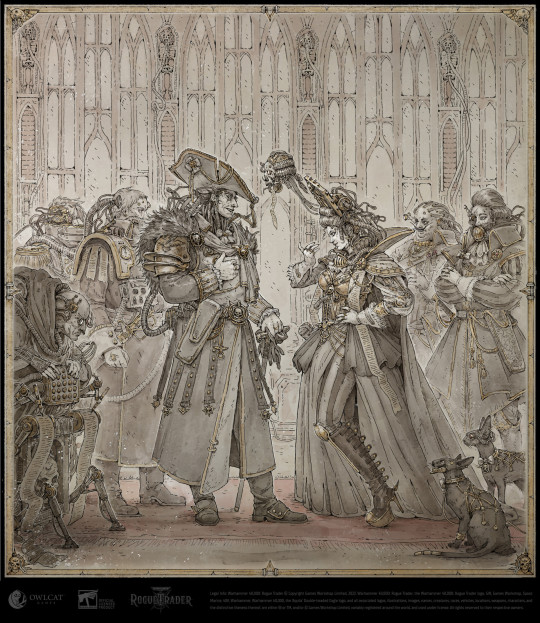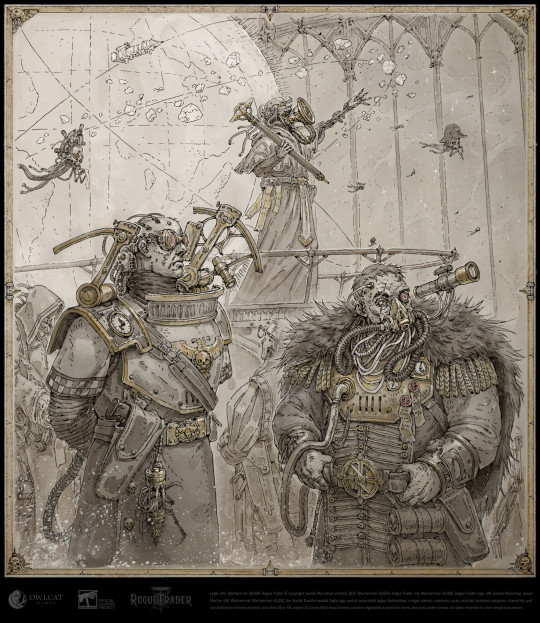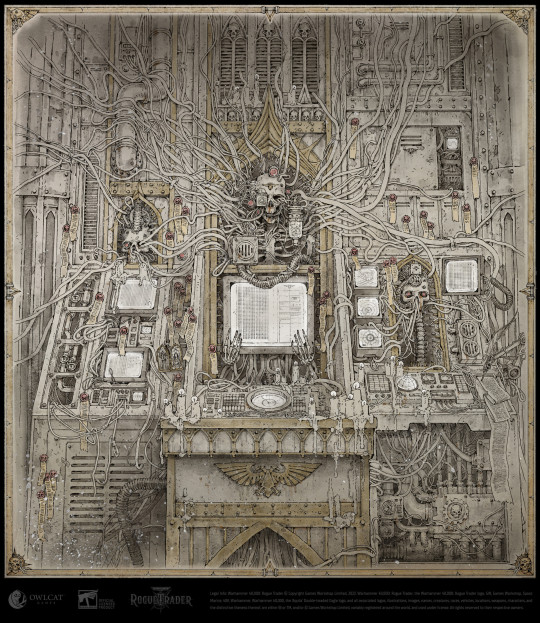#servitor
Explore tagged Tumblr posts
Text

#art#artwork#digital art#cartoon#doodle#drawing#Mortimor#warhammer#warhammer comic#warhammer art#warhammer 40000#warhammer 40k#space marine#ultramarines#space marine 2#servitor#cult mechanicus#imperium of man
1K notes
·
View notes
Text

Refueling
by Damir Šnajder
#fun#imperium#space marines#loyalist astartes#ultramarines#dreadnought#aircraft#servitor#warhammer#warhammer 40k#warhammer 40000#40k#damir snajder
455 notes
·
View notes
Text

@praxinas warlock Harlow, for the very last day of Artfight 2023!
I love the Eliksni armor from Season of Splicer and the aesthetic, just in general
#I love this piece of armor for warlock but apparently can't draw it to save my life :P#This last week was straight from the long week factory so I wasn't able to get all her details right but I tried!#Hope you enjoy!#destiny 2#It's supposed to be the big servitor from season of Splicer! Tried to photobash it together but it was rough lol#others oc#Pixel art#Pixel#Digital art#oc#artists on tumblr#cyberpunk#Eliksni#Servitor#Warlock
2K notes
·
View notes
Text
What Is An Egregore?

An egregore is a collective thought-form or psychic entity created by the shared beliefs, emotions, and intentions of a group of people. It exists on the astral plane and is sustained by the energy it receives from those who acknowledge or interact with it. Egregores can range from simple constructs, like a shared group mindset, to powerful spiritual forces that take on a life of their own.
As they become more autonomous, egregores may begin to influence even more individuals, leading them to act in ways they might not otherwise choose. They can also become malevolent, manipulating their creators or growing uncontrollable if their energy is not properly managed or if the group’s intentions shift. The longer an egregore exists, the harder it becomes to control, and it may exert a disproportionate influence over those who have fed it, making it a potentially dangerous force in occult practices.

Origins and Function
The concept of egregores dates back to ancient mystical and occult traditions, particularly in Western esotericism, Kabbalah, and ceremonial magick. The term comes from the Greek word egregoroi, meaning “watchers” or “guardians.” In modern occultism, an egregore is often likened to a psychic servitor, but instead of being created by a single person, it is formed and strengthened by collective consciousness.
Types of Egregores
• Religious & Spiritual Egregores – Gods or angels that have been empowered by centuries of belief and worship of organized religion.
• Cultural & Societal Egregores – Nations, political movements, or even corporations that develop their own energy and influence.
• Magical & Esoteric Egregores – Thought-forms created intentionally by occult groups for protection, knowledge, or power.
• Pop Culture Egregores – Fictional characters or mythologies that gain psychic influence due to mass belief and emotional investment.

How Egregores Are Sustained
An egregore requires attention, emotion, and ritual to survive. The more people interact with and reinforce its presence—through belief, symbols, rituals, or storytelling—the stronger it becomes. Some egregores can gain autonomy, influencing the thoughts and actions of those connected to them.
Working With or Disrupting Egregores
• Creating an Egregore: Occultists and magickal groups sometimes create egregores for protection, guidance, or manifestation. These are carefully built through ritual, intention, and structured feeding of energy.
• Dissolving an Egregore: If an egregore becomes negative or harmful, it can be weakened through neglect, conscious dismantling, or banishing rituals.
• Recognizing Their Influence: Many egregores subtly shape reality through collective belief. Understanding their power can help one navigate group dynamics, avoid manipulation, or harness them for magickal purposes.
Egregores exist everywhere, from spiritual traditions to modern fandoms, corporations, and ideologies. Whether viewed as independent entities or as psychological constructs, their impact on the world is undeniable, especially within witchcraft and occult circles. Learning how to recognize egregores for what they are allows a practitioner to circumvent unwanted influences and protect their energy.

#egregore#thoughtform#servitor#magick#witch#witchcraft#dark#demons#witchblr#negative#entity#haunting#manipulation#thoughts#spirit work#spirit#satanic witch#lefthandpath#eclectic witch#eclectic#pagan#paranormal#witch community#chaos#chaos witch#cults#big corporations#organized religion#chaos magick#protection
113 notes
·
View notes
Text
Servitor

We can rebuild them
91 notes
·
View notes
Text

Basics of Servitor Creation and Implementation
For those new to chaos magic, or who are unfamiliar with the terminology, a servitor is an entity created by a magician to perform certain tasks autonomous from its creator.
Phil Hine writes in Condensed Chaos: Adventures in Chaos Magic that servitors are essentially a kind of psychological complex created "by deliberately budding off portions of our psyche and identifying them by means of a name, trait, symbol", after which "we can come to work with them (and understand how they affect us) at a conscious level.”
Servitors can be created to perform a wide range of tasks, from the specific to the general, and may be considered as expert systems which are able to modify themselves to take into account new factors that are likely to arise whilst they are performing their tasks. They can be programmed to work within specific circumstances, or to be operating continually.
Phil Hine, Condensed Chaos: An Introduction to Chaos Magic (New Falcon Publications, 1995)
Note: While some purport that servitors are a part of a ‘thoughtform continuum’, starting with ‘unintelligent’ sigils and eventually getting to the complexity of egregores and godforms, I think it would be prudent to mention that I don’t think I agree with the distinctions people tend to make between servitors and thoughtforms, namely that servitors are simpler and have less agency than thoughtforms. I can see why it may be helpful for some to keep them disparate but I find the separation unnecessary especially since there are certainly instances where servitors can be sophisticated enough to harbor agency and even intellect.
Generally, I’ve seen magicians follow a model similar to Austin Osman Spare’s sigil creation technique to encode a particular intention for a servitor to operate within. Alternatively, a magician may choose to create servitors from negative aspects of their psyche so they can interact with those traits as personal ‘demons’ and eradicate them. This is to say there are probably limitless ways you can program a servitor to aid you in your magical and mundane life.
When creating a servitor, I begin with a similar mindset as creating any other magical tool by first determining my intentions. What do I need help with? What am I seeking? Try to take note of the thoughts and emotions that are influencing your intentions and even try to imagine what things will be like after the task is complete; by collecting and holding all of this mental data during servitor creation, you can strengthen the complex it is born from.
Note: This is why I find there can be varying degrees of success when trying to use a servitor that someone else has created. While someone could have had great success with their servitor and enthusiastically shared the steps for its creation, you do not have the same psychological and magical ties to that entity and therefore may not really be tapping into what makes it tick.
During this inception process, also consider the level of sophistication you want your servitor to have. Ask yourself questions like:
Is your servitor made for one specific task and then it is banished or does it work in perpetuity (or until you stop it)?
Do you have to summon it each time you need it to perform a certain task? If so, how?
Is your servitor like a magical automaton, doing a set action like a machine, or can it learn from its experiences and adapt how it operates?
Does your servitor have a lifespan? Are you able to resummon the same entity if needed again or would you create a new version of itself?
Does your servitor have agency?
Does your servitor communicate? If so, how? Can it interact with other beings besides yourself?
Does your servitor require energy or sustenance? What does it require and how often?
By having set rules or constraints baked into the creation of your servitor, you can ensure it operates the way you want it to.
As you are thinking of all of this, picture what your servitor looks like, how it moves, if it has a sound or a voice—the more detail, the better.
Give your servitor a name and a sigil. You can create the sigil based on the servitor’s name or task using something like Austin Osman Spare’s sigilization technique or something more abstract. (My personal divination deck, much like Sakura Kinomoto’s cards in Cardcaptor Sakura, also houses an entity in each of the cards and the art on the card is essentially the entity’s sigil.)
Before launching your servitor, determine a ‘kill switch’ for the entity if anything goes sideways or you need it to cease working immediately for any reason. This can be a phrase or an action but make sure it is something you cannot accidentally do. If you connect your servitor to an object, simply destroying that object would also work.
Finally, with all of this information at hand, you can launch your servitor. You can do this as you would fire off any other sigil or you can choose to do something more ceremonial. (The defunct account @trollkunnig outlines a method of essentially ‘contracting’ a servitor in this post.) At this point, you can tether your servitor to an object, if you choose to do so. I have also connected a servitor to an additional object after its programmed task was completed with a renewed intention and a course of action should its original services be needed again.
This post is part of my Magi Praxis series. If you have any suggestions for future topics, or you have attempted anything I have shared and want you share your experiences, please send me a message! I am always happy to go back and provide further explanation as well. ☆
#magick#chaos magick#chaos magic#magia#servitor#magi praxis#magical kid#magical girl#mahou shoujo#real magical girl#irl magical girl#irl mahou shoujo#pop culture magic#cardcaptor sakura#clow cards#gif
144 notes
·
View notes
Text
... Do we have Sanguinius' thoughts on cherubs?
Because I think I finally comprehended the problem and why Sanguinius is so scared and insecure, despite literally being an angel man (who is secretely a vampire, but, shhh)
65 notes
·
View notes
Text


Rogue Trader von Valancius - servant of Chaos, with Cassia and his servitors
#warhammer 40k#warhammer 40000#rogue trader#rogue_trader#wh40k#wh40k rogue trader#wh40k art#warhammercommunity#warhammer art#lineart#servitor#servo skull#cherub#psyker#artists on tumblr
77 notes
·
View notes
Text

Subject: Servitors (REAL BEINGS) Will sell BEINGS Different ages and stages of development. Will sell or give away to a new master into good hands.
Each being possesses
SIGIL ACT OF CREATION PHYSICAL RESIDENCY LOGBOOK
Ps Please do not contact me if you didn't understand what you've read. It's important for me that m beings will be well taken care of an loved! Despite my big graditude I am unable to give them as much attention anymore.
Some beings possess big achievements… Write what you need a being for and I'll try to help!
#found this when scrolling through polish deep web or someshit looking for funy things lmao#no idea what this is actually about#between drugs and malware we also found an offer with mawing lawns and petting moles#my art#oc: sevan rho 001#adeptus mechanicus#admech#dark mechanicum#shitpost#servitor#warhammer 40k#wh40k
25 notes
·
View notes
Text
youtube
youtube



My servo skull is done!
Hes my son and i love him a lot!
#my art#wh40k#warhammer 40k#warhammer 40000#3d modling#3d model#3d environment#servo skull#servitor#sanguinius#uuu this was super fun!!#Youtube
27 notes
·
View notes
Text









by Anastasiya Landasseln
#rogue traders#locations#spaceship#servo skull#servitor#adeptus mechanicus#warhammer#warhammer 40k#warhammer 40000#40k#anastasiya landasseln#monochrome#imperium
2K notes
·
View notes
Text
Servitors: Your Personal Magical Minions (No Payroll Required!)

So, You Want a Magical Minion?
Let’s be honest—who hasn’t wished they had a little helper to handle life’s tedious tasks? Imagine having a personal assistant, but instead of a human (or a very expensive AI subscription), you have a magical entity that exists solely to do your bidding. No snack breaks, no salary, no complaining about workplace conditions. Welcome to the world of servitors!
Servitors are artificial spirits created for a specific purpose, and they’re entirely under your control. Need protection? A servitor can be your mystical bodyguard. Looking to attract opportunities? A servitor can work as your personal energetic recruiter. The possibilities are endless, as long as you know what you’re doing.
But before you go off creating an army of these things like some kind of magical overlord, let’s dive into what servitors are, how they differ from egregores, and how to make them work for you.
Servitors vs. Egregores: What's the Difference?
Many people confuse servitors with egregores, so let’s clear that up. While both are thought-forms—entities created through focused thought and energy—they serve different functions and have different levels of autonomy.
🔹 Servitors are personal and programmed. You create them with a specific purpose in mind, and they are bound to you. They act like well-trained magical pets: loyal, obedient, and existing only as long as you choose to maintain them.
🔹 Egregores are collective thought-forms created by a group’s shared beliefs and intentions. Think of them as corporate mascots with a touch of spiritual power. Major religions, brands, and even fandoms have egregores that take on lives of their own (looking at you, Mickey Mouse and Santa Claus).
While servitors are like robots designed for specific tasks, egregores are more like cultural forces—harder to control and capable of influencing large groups of people.
Why Create a Servitor?
The real question is, why wouldn’t you want a magical assistant? Here are some common uses for servitors:
✅ Protection: Keep negative energy, harmful spirits, and sketchy people at bay. ✅ Prosperity: Attract money, job opportunities, or even creative inspiration. ✅ Healing: Act as an energy worker to aid in physical or emotional healing. ✅ Enhancing Skills: Boost your intuition, psychic abilities, or even productivity. ✅ Emotional Support: A servitor can be designed to provide comfort or motivation.
You get to decide exactly what the servitor does, and you tailor it to your needs.
How to Create a Servitor
Ready to build your own magical companion? Follow these steps, and soon you’ll have a fully functional servitor at your service.
Step 1: Define the Purpose
Before anything else, be crystal clear about what you want your servitor to do. The more specific, the better. A servitor for “helping with work” is too vague, but a servitor “to enhance my confidence when speaking in meetings” is a focused goal.
Step 2: Design Its Form
Servitors don’t have a default look, so get creative! You can design them to appear as:
A shadowy protector
A glowing orb of energy
A small, helpful imp
A wise owl or cat familiar
The form should match the function. A servitor for confidence might take the shape of a lion, while one for stealth could be a smoky, formless wisp.
Step 3: Give It a Name
Names hold power. Choose something easy to remember but unique enough that you don’t accidentally summon it when ordering takeout.
Step 4: Charge It with Energy
To bring your servitor to life, you need to pour energy into it. This can be done through:
Meditation and visualization
Chanting its name repeatedly
Drawing or sculpting its form
Using candle magic, sigils, or crystals
Some practitioners even use a ritual circle to mark the servitor’s “birth.”
Step 5: Program Its Instructions
Like training a puppy (but with fewer messes), you must teach your servitor what to do. Be clear and direct. You can write down its purpose, speak aloud to it, or mentally command it.
Example: “You are to increase my focus while studying. Whenever I sit down with a book, you will sharpen my concentration and block out distractions.”
Step 6: Assign a Home
Your servitor needs an anchor in this world. You can link it to an object (a crystal, a piece of jewelry, a drawing) or even keep it within your aura. This prevents it from dissipating.
Step 7: Feed It (But Not with Food!)
Servitors need energy to function. You can feed them with:
Your focus and intention
Offerings of light, incense, or sigil activations
Absorbing excess energy from specific sources (like the sun, moon, or even music)
If a servitor gets too weak, it might dissolve on its own.
Step 8: Dismiss or Destroy When Done
If you no longer need your servitor, it’s important to properly dissolve it. This prevents lingering energy from going rogue.
To dismiss a servitor, you can:
Thank it for its service and instruct it to dissolve.
Burn its sigil or physical representation.
Absorb its energy back into yourself or the universe.
Warnings and Ethics of Servitor Work
🚨 Do NOT create servitors for harm. They can backfire or grow beyond your control. 🚨 Do NOT forget about them. A neglected servitor can become unstable. 🚨 DO set clear limits. Make sure your servitor knows its purpose and doesn’t overstep its bounds.
Remember, servitors are tools—not independent spirits or pets. Treat them with respect, but always stay in control.
Final Thoughts: The Magical Workforce at Your Fingertips
Creating servitors is a powerful magical technique that allows you to shape reality in a unique way. They are the ultimate customizable magical assistants, designed to fit your exact needs without any unnecessary fluff. Whether you want help manifesting money, sharpening your intuition, or keeping bad vibes away, servitors can be a valuable addition to your practice.
So, what kind of servitor will you create? Let me know in the comments!
╔══ ∙∘𓆩⟡𓆪∘∙ ════════╗
How to Support the Blog
╚════════ ∙∘𓆩⟡𓆪∘∙ ══╝
💜 Love the blog? Subs on Ko-fi & Patreon (18+) get to see posts before they go live on Tumblr! I also offer readings and spells in my Ko-fi Shop!
#witchblr#witchythings#witchcraft blog#witchcraft info#witches#witchcraft 101#witch community#witchcraft#healing energy#learning magick#chaos magick#magick#servitor
41 notes
·
View notes
Text
Technomancy: The Fusion Of Magick And Technology

Technomancy is a modern magickal practice that blends traditional occultism with technology, treating digital and electronic tools as conduits for energy, intent, and manifestation. It views computers, networks, and even AI as extensions of magickal workings, enabling practitioners to weave spells, conduct divination, and manipulate digital reality through intention and programming.
Core Principles of Technomancy
• Energy in Technology – Just as crystals and herbs carry energy, so do electronic devices, circuits, and digital spaces.
• Code as Sigils – Programming languages can function as modern sigils, embedding intent into digital systems.
• Information as Magick – Data, algorithms, and network manipulation serve as powerful tools for shaping reality.
• Cyber-Spiritual Connection – The internet can act as an astral realm, a collective unconscious where digital entities, egregores, and thought-forms exist.
Technomantic Tools & Practices
Here are some methods commonly utilized in technomancy. Keep in mind, however, that like the internet itself, technomancy is full of untapped potential and mystery. Take the time to really explore the possibilities.
Digital Sigil Crafting
• Instead of drawing sigils on paper, create them using design software or ASCII art.
• Hide them in code, encrypt them in images, or upload them onto decentralized networks for long-term energy storage.
• Activate them by sharing online, embedding them in file metadata, or charging them with intention.
Algorithmic Spellcasting
• Use hashtags and search engine manipulation to spread energy and intent.
• Program bots or scripts that perform repetitive, symbolic tasks in alignment with your goals.
• Employ AI as a magickal assistant to generate sigils, divine meaning, or create thought-forms.

Digital Divination
• Utilize random number generators, AI chatbots, or procedural algorithms for prophecy and guidance.
• Perform digital bibliomancy by using search engines, shuffle functions, or Wikipedia’s “random article” feature.
• Use tarot or rune apps, but enhance them with personal energy by consecrating your device.
Technomantic Servitors & Egregores
• Create digital spirits, also called cyber servitors, to automate tasks, offer guidance, or serve as protectors.
• House them in AI chatbots, coded programs, or persistent internet entities like Twitter bots.
• Feed them with interactions, data input, or periodic updates to keep them strong.
The Internet as an Astral Plane
• Consider forums, wikis, and hidden parts of the web as realms where thought-forms and entities reside.
• Use VR and AR to create sacred spaces, temples, or digital altars.
• Engage in online rituals with other practitioners, synchronizing intent across the world.
Video-game Mechanics & Design
• Use in-game spells, rituals, and sigils that reflect real-world magickal practices.
• Implement a lunar cycle or planetary influences that affect gameplay (e.g., stronger spells during a Full Moon).
• Include divination tools like tarot cards, runes, or pendulums that give randomized yet meaningful responses.

Narrative & World-Building
• Create lore based on historical and modern magickal traditions, including witches, covens, and spirits.
• Include moral and ethical decisions related to magic use, reinforcing themes of balance and intent.
• Introduce NPCs or AI-guided entities that act as guides, mentors, or deities.
Virtual Rituals & Online Covens
• Design multiplayer or single-player rituals where players can collaborate in spellcasting.
• Implement altars or digital sacred spaces where users can meditate, leave offerings, or interact with spirits.
• Create augmented reality (AR) or virtual reality (VR) experiences that mimic real-world magickal practices.
Advanced Technomancy
The fusion of technology and magick is inevitable because both are fundamentally about shaping reality through will and intent. As humanity advances, our tools evolve alongside our spiritual practices, creating new ways to harness energy, manifest desires, and interact with unseen forces. Technology expands the reach and power of magick, while magick brings intention and meaning to the rapidly evolving digital landscape. As virtual reality, AI, and quantum computing continue to develop, the boundaries between the mystical and the technological will blur even further, proving that magick is not antiquated—it is adaptive, limitless, and inherently woven into human progress.

Cybersecurity & Warding
• Protect your digital presence as you would your home: use firewalls, encryption, and protective sigils in file metadata.
• Employ mirror spells in code to reflect negative energy or hacking attempts.
• Set up automated alerts as magickal wards, detecting and warning against digital threats.
Quantum & Chaos Magic in Technomancy
• Use quantum randomness (like random.org) in divination for pure chance-based outcomes.
• Implement chaos magick principles by using memes, viral content, or trend manipulation to manifest desired changes.
AI & Machine Learning as Oracles
• Use AI chatbots (eg GPT-based tools) as divination tools, asking for symbolic or metaphorical insights.
• Train AI models on occult texts to create personalized grimoires or channeled knowledge.
• Invoke "digital deities" formed from collective online energies, memes, or data streams.
Ethical Considerations in Technomancy
• Be mindful of digital karma—what you send out into the internet has a way of coming back.
• Respect privacy and ethical hacking principles; manipulation should align with your moral code.
• Use technomancy responsibly, balancing technological integration with real-world spiritual grounding.
As technology evolves, so will technomancy. With AI, VR, and blockchain shaping new realities, magick continues to find expression in digital spaces. Whether you are coding spells, summoning cyber servitors, or using algorithms to divine the future, technomancy offers limitless possibilities for modern witches, occultists, and digital mystics alike.

"Magick is technology we have yet to fully understand—why not merge the two?"
#tech witch#technomancy#technology#magick#chaos magick#witchcraft#witch#witchblr#witch community#spellwork#spellcasting#spells#spell#sigil work#sigil witch#sigil#servitor#egregore#divination#quantum computing#tech#internet#video games#ai#vr#artificial intelligence#virtual reality#eclectic witch#eclectic#pagan
94 notes
·
View notes
Text




by Dahmernation
41 notes
·
View notes
Text

Through a long and strange turn of events, this old chainsaw-carved sculpture has found herself stationed at our front gate. I call her the Watcher Woman, and she has quickly endeared herself to our home and us. I think it likely that she will eventually become a gatekeeper Servitor. In truth, she may already be in the early stages of taking on that role, though inadvertently.
32 notes
·
View notes
